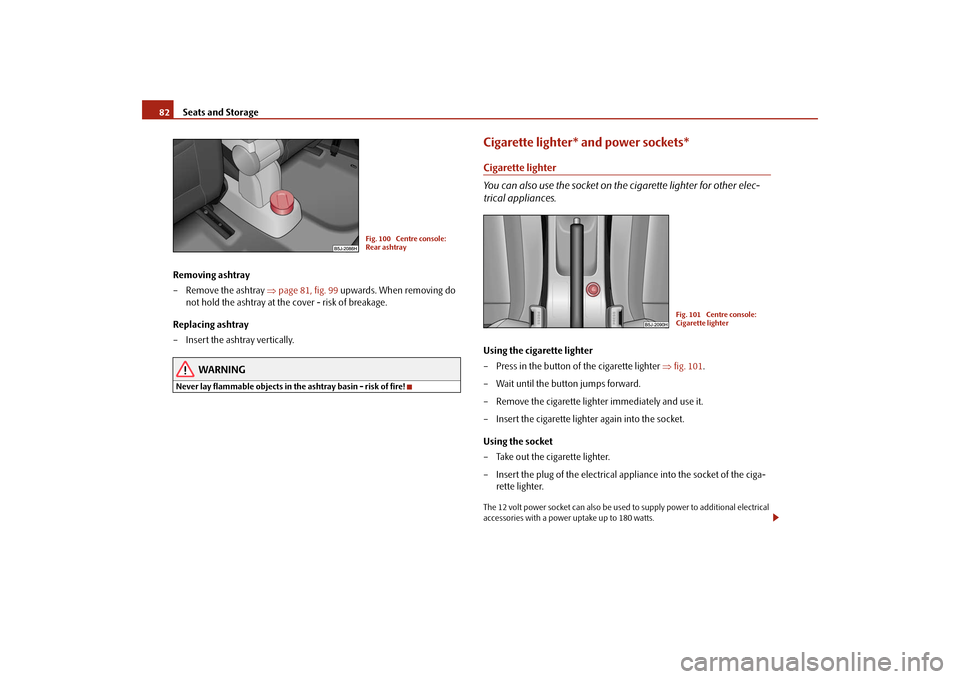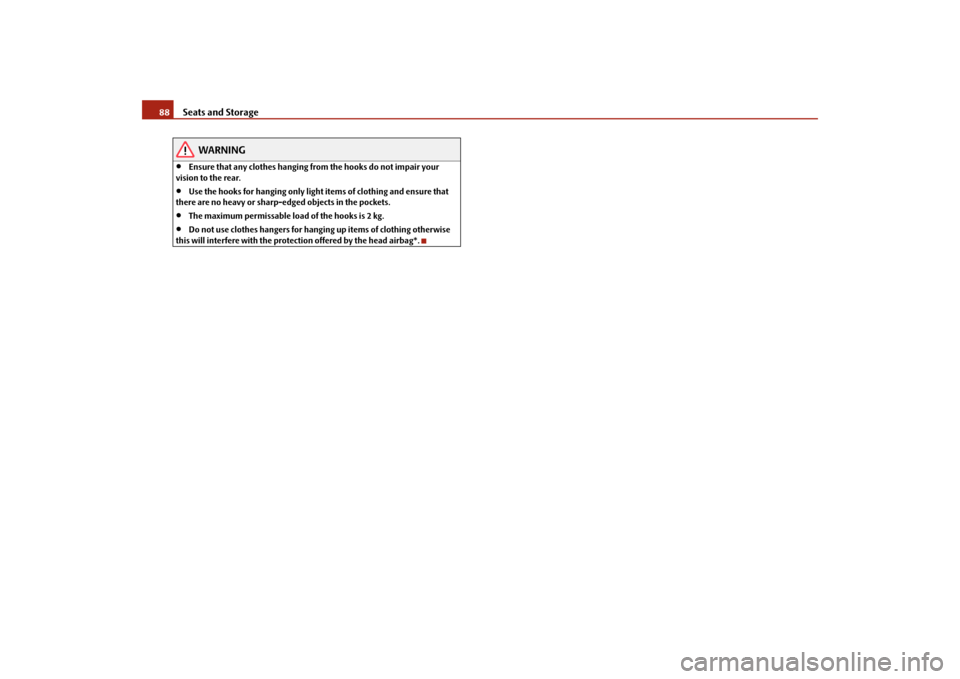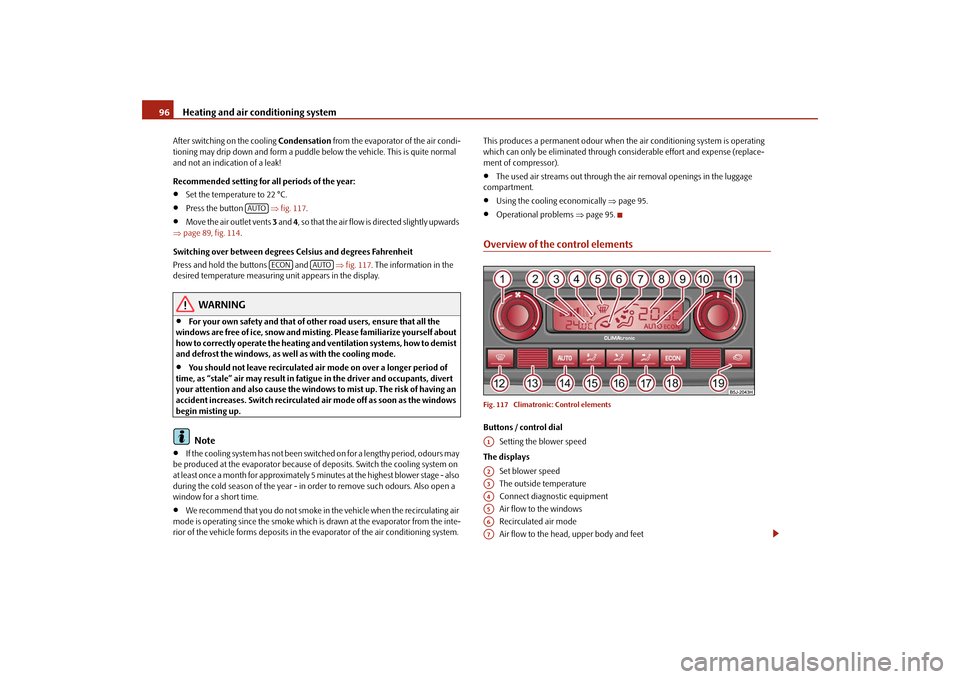2009 SKODA ROOMSTER Light
[x] Cancel search: LightPage 78 of 263

Seats and Storage77
Using the system
Safety
Driving Tips
General Maintenance
Breakdown assistance
Praktik
Technical Data
Bicycle carrier*Install cross member– Remove the rear seats or fold the seats fully forwards, in order to make
available the necessary space in the luggage compartment
⇒page 68.
– Release the fixtures at the ends of the cross member by slightly
pulling up the securing screws .
– Position the cross member with the fixed (not pulled out) part onto
the (in direction of travel) right lashing eye and then the pull-out part
onto the left lashing eye.
– Secure the fixture to both sides and lock the fixing screws in
place.
– Tighten the fixing screws up to the stop.
– Check the attachment of the cross member by pulling it.
WARNING
When transporting the bicycles in the luggage compartment, ensure the
safety of the passengers transported on the rear seats ⇒page 130, “Correct
seated position for the occupants on the rear seats”.Install bicycle carrier– Position the approved bicycle carrier on the cross member, after
pulling up the screw push the frame side rail (alu-part) towards the
cross member and screw the screw into the nut ⇒fig. 90.
– Slacken the screw on the moveable part of the bicycle carrier and
pull out, then position the moveable part of the carrier, depending on
bicycle size, into one of the three possible positions.
– Insert the screw into the desired position and tighten.
Fig. 89 Install cross member
AB
AC
AA
AB
AC
AC
Fig. 90 Install bicycle carrier
AA
AA
ABAB
s29g.4.book Page 77 Wednesday, June 17, 2009 9:54 AM
Page 83 of 263

Seats and Storage 82
Removing ashtray
– Remove the ashtray ⇒page 81, fig. 99 upwards. When removing do
not hold the ashtray at the cover - risk of breakage.
Replacing ashtray
– Insert the ashtray vertically.
WARNING
Never lay flammable objects in the ashtray basin - risk of fire!
Cigarette lighter* and power sockets*Cigarette lighter
You can also use the socket on the cigarette lighter for other elec-
trical appliances.Using the cigarette lighter
– Press in the button of the cigarette lighter ⇒fig. 101.
– Wait until the button jumps forward.
– Remove the cigarette lighter immediately and use it.
– Insert the cigarette lighter again into the socket.
Using the socket
– Take out the cigarette lighter.
– Insert the plug of the electrical appliance into the socket of the ciga-
rette lighter.The 12 volt power socket can also be used to supply power to additional electrical
accessories with a power uptake up to 180 watts.
Fig. 100 Centre console:
Rear ashtray
Fig. 101 Centre console:
Cigarette lighter
s29g.4.book Page 82 Wednesday, June 17, 2009 9:54 AM
Page 84 of 263

Seats and Storage83
Using the system
Safety
Driving Tips
General Maintenance
Breakdown assistance
Praktik
Technical Data
WARNING
•
Take care when using the cigarette lighter! Not paying proper attention
or incorrect use the cigarette lighter in an uncontrolled manner may result in
burns.
•
The cigarette lighter and the power socket also operates when the igni-
tion is switched off or the ignition key withdrawn. This is why you should
never leave children unattended in the vehicle!Caution
Only use matching plugs, which fulfils the DIN - ISO Standard 4165, to avoid
damaging the power sockets.
Note
Connecting electrical components when the engine is not running will drain
the battery of the vehicle - risk of battery draining!Power socket in the luggage compartment– Open the cover of the power socket ⇒fig. 102.
– Connect the plug of the electrical appliance to the socket.
The power socket, which fulfils the requirements of DIN standard ISO 4165, must
only be used for connecting approved electrical accessories with a power uptake of
up to 240 watts. The vehicle battery will be discharged in the process if the engine
is stationary.
The same remarks apply here as for ⇒page 82, “Cigarette lighter”.
Further information ⇒page 204, “Accessories, changes and replacement of
parts”.Storage compartmentsOverviewYou will find the following storage facilities in your vehicle:
WARNING
•
Please do not place anything on top of the dash panel. Such objects
might slide or fall down when driving (when accelerating or cornering) and
may distract you from concentrating on the traffic situation - risk of acci-
dent!
Fig. 102 Luggage compart-
ment: Power socket
Storage compartments on the front passenger side*
⇒page 84
Storage compartment on the driver's side
⇒page 85
Storage compartment for spectacles*
⇒page 85
Stowage compartment in centre console
⇒page 85
Storage compartment in the front seat*
⇒page 85
Front seat armrest with storage compartment*
⇒page 86
Storage compartment in the front doors
⇒page 86
Storage compartments in the luggage compartment
⇒page 87
Flexible storage compartment*
⇒page 87
Clothes hooks*
⇒page 87
s29g.4.book Page 83 Wednesday, June 17, 2009 9:54 AM
Page 89 of 263

Seats and Storage 88
WARNING
•
Ensure that any clothes hanging from the hooks do not impair your
vision to the rear.
•
Use the hooks for hanging only light items of clothing and ensure that
there are no heavy or sharp-edged objects in the pockets.
•
The maximum permissable load of the hooks is 2 kg.
•
Do not use clothes hangers for hanging up items of clothing otherwise
this will interfere with the protection offered by the head airbag*.
s29g.4.book Page 88 Wednesday, June 17, 2009 9:54 AM
Page 90 of 263

Heating and air conditioning system89
Using the system
Safety
Driving Tips
General Maintenance
Breakdown assistance
Praktik
Technical Data
Heating and air conditioning systemAir outlet ventsFig. 114 Air outlet ventsOpen air outlet vents
– Turn the rotary knob into the upper position.
Close air outlet vents
– Turn the rotary knob into the lower position.
Redirecting air flow
– The horizontal as well as the vertical direction of the air flow is set with
the handle in the middle of the air outlet vents.You can set the air supply to the individual vents with the air distribution control
⇒page 90, fig. 115. Air outlet vents 3 and 4 can also be opened or closed individ-
ually.
Unwarmed or cooled air will flow out of the opened air outlet vents according to
the setting of the control dial ⇒page 90, fig. 115 and according to atmospheric
conditions.
Recirculated air modeIn recirculated air mode air is sucked out of the interior of the vehicle
and then fed back into the interior.Recirculated air mode prevents polluted air outside the vehicle from
getting into the vehicle, for example when driving through a tunnel or
when standing in a traffic jam.
Switching recirculated air mode on
– Press button , the button symbol
lights up ⇒page 90, fig. 115.
Switching recirculated air mode off
– Press button again, the button symbol
goes out.
The recirculated air mode is switched off automatically if the air distribution control
is in position
⇒page 90, fig. 115. You can also switch recirculated air mode
on again from this setting by repeatedly pressing button .
WARNING
You should not leave recirculated air mode on over a longer period of time,
as “stale” air may result in fatigue in the driver and occupants, divert your
attention and also cause the windows to mist up. The risk of having an acci-
dent increases. Switch recirculated air mode off as soon as the windows
begin misting up.
AC
AA
AC
s29g.4.book Page 89 Wednesday, June 17, 2009 9:54 AM
Page 96 of 263

Heating and air conditioning system95
Using the system
Safety
Driving Tips
General Maintenance
Breakdown assistance
Praktik
Technical Data
Using the air conditioning system economicallyThe compressor on the Climatic uses power from the engine when in cooling mode
which will effect the fuel consumption.
It recommended to open the windows or the doors of a vehicle for which the inte-
rior has been strongly heated through the effect of direct sunlight in order to allow
the heated air to escape.
The cooling system should not be switched on while travelling when the window is
open.
The desired interior temperature can also be achieved without switching in the
cooling system just by switching to fresh air mode.
For the sake of the environment
When you economize on fuel, you also reduce pollutant emissions.Operational problemsIf the cooling system does not operate at outside temperatures higher than +2 °C,
there is a problem in the system. The reasons for this may be:•
The fuse of the Climatic is defective. Check the fuse, replace it if necessary
⇒page 218.
•
The cooling system has switched off automatically for a short time because the
coolant temperature of the engine is too hot ⇒page 19.
If you are not able to rectify the operational problem yourself, or if the cooling
capacity decreases, switch the cooling system off. Contact a specialist garage.
If there is a fault at the Climatronic, all symbols on the display flash after switching
on the ignition for 15 seconds. Contact a specialist garage.
Climatronic (automatic air conditioning)*Description
The Climatronic system is a combination of an automatic heating,
fresh air and cooling system which provides optimal comfort for the
occupants of the car.The Climatronic maintains a constant temperature fully automatically, once it has
been set. This is achieved by automatically varying the temperature of the
outflowing air, the blower stages and the air distribution. The system also takes into
account sunlight which eliminates the need to alter the settings manually. The
automatic mode ⇒page 97 ensures maximum wellbeing of the occupants at all
times of the year.
Description of Climatronic system
The cooling operates only if the following conditions are met:•
engine running,
•
outside temperature above +2°C,
•
the button is not pressed.
If the cooling system is switched on, the temperature and air humidity drops in the
vehicle. The wellbeing of the occupants of the car is enhanced as a result of this
particularly at high outside temperatures and a high air humidity. The system
prevents the windows misting up during the cold season of the year.
The heating effect is dependent upon the coolant temperature, thus full heat
output only occurs when the engine has reached its operating temperature.
It is possible to briefly activate recirculated air mode in order to enhance the
cooling effect ⇒.
The air inlet in front of the windscreen must be free of ice, snow or leaves in order
to ensure that the heating and cooling systems operate properly.
The AC compressor is switched off at a high coolant temperature in order to provide
cooling at a high load of the engine.
ECON
s29g.4.book Page 95 Wednesday, June 17, 2009 9:54 AM
Page 97 of 263

Heating and air conditioning system 96After switching on the cooling Condensation from the evaporator of the air condi-
tioning may drip down and form a puddle below the vehicle. This is quite normal
and not an indication of a leak!
Recommended setting for all periods of the year:•
Set the temperature to 22 °C.
•
Press the button ⇒fig. 117.
•
Move the air outlet vents 3 and 4, so that the air flow is directed slightly upwards
⇒page 89, fig. 114.
Switching over between degrees Celsius and degrees Fahrenheit
Press and hold the buttons and ⇒fig. 117. The information in the
desired temperature measuring unit appears in the display.
WARNING
•
For your own safety and that of other road users, ensure that all the
windows are free of ice, snow and misting. Please familiarize yourself about
how to correctly operate the heating and ventilation systems, how to demist
and defrost the windows, as well as with the cooling mode.
•
You should not leave recirculated air mode on over a longer period of
time, as “stale” air may result in fatigue in the driver and occupants, divert
your attention and also cause the windows to mist up. The risk of having an
accident increases. Switch recirculated air mode off as soon as the windows
begin misting up.Note
•
If the cooling system has not been switched on for a lengthy period, odours may
be produced at the evaporator because of deposits. Switch the cooling system on
at least once a month for approximately 5 minutes at the highest blower stage - also
during the cold season of the year - in order to remove such odours. Also open a
window for a short time.
•
We recommend that you do not smoke in the vehicle when the recirculating air
mode is operating since the smoke which is drawn at the evaporator from the inte-
rior of the vehicle forms deposits in the evaporator of the air conditioning system. This produces a permanent odour when the air conditioning system is operating
which can only be eliminated through considerable effort and expense (replace-
ment of compressor).
•
The used air streams out through the air removal openings in the luggage
compartment.
•
Using the cooling economically ⇒page 95.
•
Operational problems ⇒page 95.
Overview of the control elementsFig. 117 Climatronic: Control elementsButtons / control dial
Setting the blower speed
The displays
Set blower speed
The outside temperature
Connect diagnostic equipment
Air flow to the windows
Recirculated air mode
Air flow to the head, upper body and feet
AUTO
ECON
AUTO
A1A2A3A4A5A6A7
s29g.4.book Page 96 Wednesday, June 17, 2009 9:54 AM
Page 98 of 263

Heating and air conditioning system97
Using the system
Safety
Driving Tips
General Maintenance
Breakdown assistance
Praktik
Technical Data Display of selected interior temperature, here: +20 °C
Automatic mode
ECON mode
Buttons / control dial
Setting the interior temperature
Air flow to the windows
Automatic mode
Air flow in the footwell
Air flow to the upper body
Air flow to head
Button for switching off cooling system
Recirculated air mode
Note
The interior temperature sensor is located in the bottom part of the device. Do
not glue or cover over the sensor, otherwise it could have an unfavourable effect on
the Climatronic.Automatic mode
The automatic mode is used in order to maintain a constant temper-
ature and to keep the windows in the interior of the car dry.Switching automatic mode on
– Set a temperature between +18 °C and +29 °C.
– Move the air outlet vents 3 and 4 ⇒page 89, fig. 114, so that the air
flow is directed slightly upwards.
– Press the button , AUTO appears in the display.The automatic mode is switched off by pressing the button for the air distribution
or increasing or decreasing the blower speed. The temperature is nevertheless
regulated.
ECON mode
The cooling system is switched off in the ECON mode - heating and
ventilation are regulated automatically.Switching ECON mode on
–Press the button , ECON appears in the display.
– Set a temperature between +18 °C and +29 °C.
Recirculated air mode in ECON mode
– First of all press the button , AUTO appears in the display.
– Then press the button , ECON appears in the display.The ECON mode operates only within the control temperature range from +18°C
up to +29°C.
The ECON mode is switched off when pressing button or .
Please note that, in the ECON mode, the interior temperature cannot be lower than
the outside temperature. The interior is not cooled and the air is not dehumidified.
Please refer to the information regarding recirculated air mode ⇒page 89, “Recir-
culated air mode”.Defrosting windscreenDefrosting windscreen - switching on
–Press the button ⇒page 96, fig. 117.
Defrosting windscreen - switching off
– Once again press the button or the button .The temperature control is controlled automatically. More air flows out of the air
outlet vents 1 and2.
A8A9A10A11A12A14A15A16A17A18A19
A13
AUTO
ECON
ECON
AUTO
s29g.4.book Page 97 Wednesday, June 17, 2009 9:54 AM